Ningaloo Reef’s whale sharks and humpacks an annual bonanza
Some of the ocean’s biggest and smallest creatures are the unforgettable highlights of a scuba diving trip on Ningaloo Reef.

It’s August and the humpback whales have arrived at Ningaloo Reef in their thousands to calve and mate on their northerly migration from Antarctica. Manta ray numbers are peaking, and whale shark season is in full swing, with tour boats reportedly booked out. Of Ningaloo’s Big Three, it’s the whale sharks that steal the limelight. Neither whale nor shark, the world’s biggest fish, which grows up to 18m long, congregates in these Western Australian waters from March to feast on plankton. Tour operators sail from the western side of the North West Cape, using spotter planes so they can plonk snorkellers along the spotted giants’ swimming routes. It’s a carefully controlled outing in which humans look from a distance but definitely don’t touch.
Setting sail from the town of Exmouth on the Coral Coast, I’m excited at the possibility of seeing the Big Three. On my trip, though, chances of seeing a whale shark will be driven purely by luck. There will be no pilots to lead the way. I’ve joined 17 other hopeful guests on Lady Ningaloo, a liveaboard dive boat that was recently launched by local scuba operator Dive Ningaloo. We’re surrendering the west coast of the cape to the tour boats and planes, and heading for the reef’s northern reaches, the Muiron Islands. Despite the long odds, we’re all eager to tick the Big Three off our wish lists.
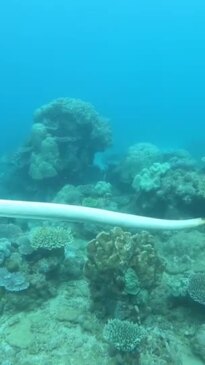
Dave Ross, Dive Ningaloo’s co-owner, discovered the former passenger ferry wasting away on a dry dock and destined for the scrap heap. The catamaran had once serviced Lady Musgrave Island off Bundaberg in Queensland, and he saw its potential as the liveaboard vessel he’d long dreamed of. After an 18-month fit-out in Malaysia, it arrived in WA with nine ensuite cabins able to accommodate 18 guests, a communal dining room, and a spacious aft deck with outdoor couches where passengers can swap tales of underwater sightings. The lower deck is fitted out for dive gear, complete with a compressor, while the upper deck is the spot for topping up Vitamin D levels or watching the sunset from a camp chair. This is not a luxury boat but it is comfortable, with aircon in all cabins and functional compact bathrooms that have deliciously hot showers to warm guests up after a dive.
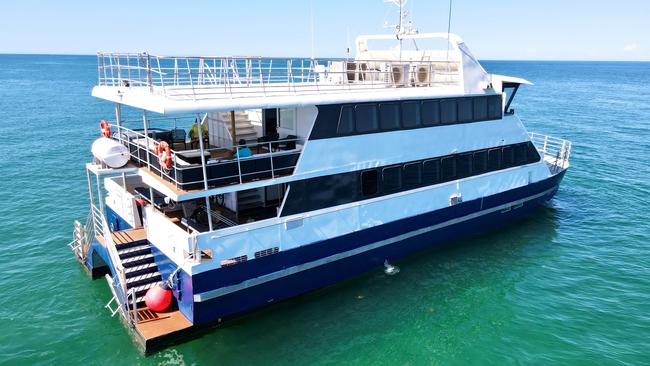
I’m going to show my hand early – the whale sharks are a no-show, but what I do see makes it clear why Ningaloo was declared a UNESCO World Heritage area in 2011. This is an incredible marine environment, home to 250 species of hard and soft coral and more than 500 species of fish. One of the world’s longest fringing reefs, it stretches 300km north from Carnarvon, and many of its sights are easily accessible with just a gentle paddle from the beach.
Guests on this expedition are a mix of Aussies, Americans and Brits – experienced divers, beginners and snorkellers, ranging in age from 20 to 70-plus. As we cruise into our first vivid sunset we set about getting to know one another. Lady Ningaloo has been in motion for barely 15 minutes when the first blow of a humpback is spotted, and suddenly we’re all peering out to sea and pointing here, there and everywhere. I knew there was a chance of spotting whales but over the course of three days they become a constant source of entertainment and wonder. An estimated 30,000 humpbacks pass through Ningaloo’s nutrient-rich waters at this time of year. Later in the season they mooch into Exmouth Gulf to rest and feed, attracting another large species, orcas, which prey on the calves. I’m grateful to be here too early to witness nature’s brutal cycle of life and death in action. Instead, we’re treated to repeated uplifting scenes of cretaceous parenting.
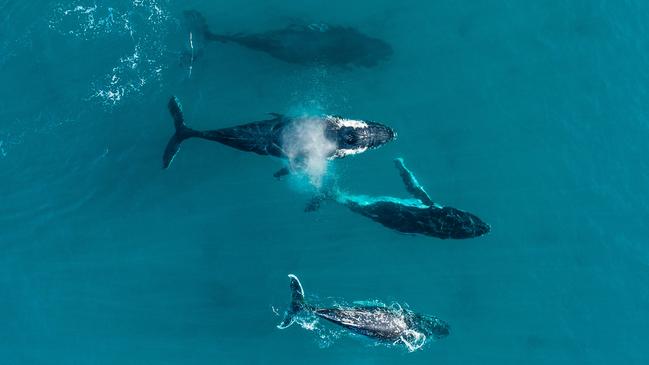
One afternoon, after spotting a large black blob bobbing on the ocean’s surface, Captain Dave slows the boat. The blob turns out to be a stationary humpback with a baby; a glistening grey bundle of joy about the size of a large dolphin. Mum’s white underbelly is visible and the youngster is nursing. Nearby, another newbie breaches playfully next to its mother. At times we see bubs piggybacking on their mother’s back. These little ones guzzle up to 500 litres of milk each day, piling on a whopping 45kg in the same period. Another day, three whales head straight for the boat like benign torpedoes, dipping below the twin hulls before emerging on the other side. One swings back as though to take another look. It’s so close we can see the barnacles on its stumpy dorsal fin.
Lady Ningaloo’s crew are a laidback blend of multitasking Australians, French and Spanish, serving meals one minute and guiding divers the next. In charge of the galley on my trip is French chef Gabriel, who dishes up lunches of banh mi stuffed with tofu and coriander or housemade sausage rolls with salad, and dinners of beef cheek accompanied by cooked cos lettuce with dehydrated egg, and slow-roasted lamb shoulder on a bed of beans, capsicum and pesto. Desserts range from tubs of yummy vegan caramel ice cream to his piece de resistance, a perfectly scorched lemon meringue tart. When we return from a dive, of which there are a minimum three a day, there might be freshly baked friands, date loaf or hot toasties waiting.


I do eight dives during our voyage and each one delivers a different seascape of vibrant coral gardens and marine life. Ningaloo has so far avoided the consecutive bleaching events seen on the Great Barrier Reef caused by dramatic spikes in water temperature, though we do spy a few ugly crown of thorns starfish. The coral coverage is impressively healthy, ranging widely from huge plate coral, enormous bommies like planets, encircled by resident fish, and soft corals swaying in the current. There is so much to see it’s impossible to keep track. Giant potato cod stare grumpily at the human intruders, an octopus attempts to disguise itself as a rock, and a wobbegong perches under a coral shelf, tail neatly curled like a cat’s. Two white-tipped reef sharks glide sharply into view before disappearing into the murk and there are a handful of turtle sightings. A few guests are lucky enough to see manta-rays.
I arrived at Exmouth hoping to see some of the great creatures of the deep but instead am captivated by much smaller quarry. Tiny nudibranchs, wildly coloured slugs with feathery headdresses and polka-dotted and stripy bodies, become something of an obsession. With my dive buddy, a polite young man called Ed, I “collect” them like Pokemon, photographing their 3cm lengths then cross-checking them with pictures in a “what’s that fish” guidebook. I’m not the only person with a nudibranch fixation. Search online and you’ll find that someone with perhaps too much time on their hands has matched the charismatic critters with the multiple personas of the late David Bowie, from Ziggy Stardust and Major Tom onwards. The marine oddity’s resemblance to the Thin White Duke’s take on fashion is remarkable.
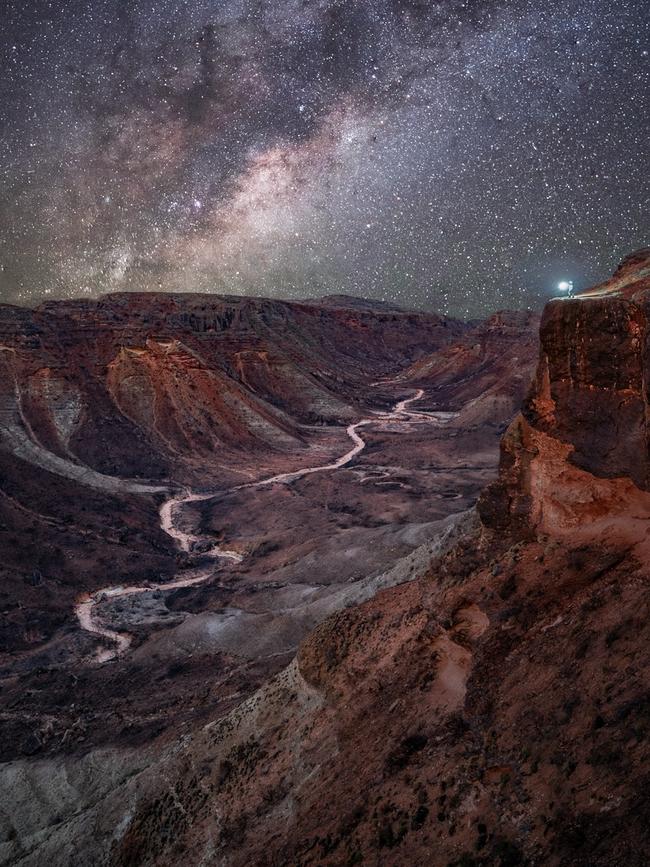
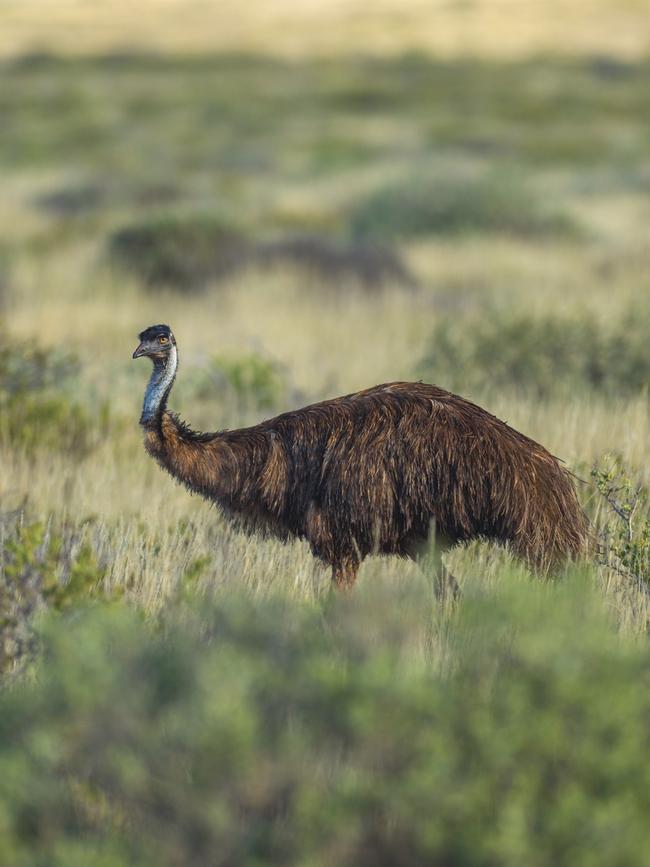
Then there are the two perfectly polished tiger cowrie shells, inhabited by sea snails, that I spy on a lump of coral, and the whiskery black catfish, endemic to the northwest, snuffling around in the sand. And the olive sea snakes, whose bold curiosity is frankly alarming as they glide beneath my nose and become entangled in my legs. (Yes, they are extremely poisonous but biting is the last thing on their mind, unless it’s a love bite; it’s mating season, too, for these amorous reptiles.)
We’re all hoping a humpback will choose to swim past while we’re in the water but, like their spotty cousins, they prove elusive. We know they are out there, though. We can hear them; long mournful moans and sharp clicks carry through the water. The first time I hear it, it stops me in my tracks. Then it becomes a soundtrack, produced by giants, as I search for the reef’s tiny treasures. Africa has the Big Five – rhino, leopard, lion, elephant and buffalo. Ningaloo has the Big Three. These numerical marketing gimmicks neatly encapsulate both destinations’ main attractions, but they also drastically undersell their broader appeal. Sometimes, as I’ve discovered, it is the little things that count.

IN THE KNOW
Whale season runs from June to November on the Coral Coast. Whale sharks can be spotted from March to August, while manta-rays are most plentiful between May and November. Green and loggerhead turtles come to the coast to nest from November to March. Dive Ningaloo offers three and seven-night trips on Lady Ningaloo from Exmouth. Three-night itineraries are $2700 a person, twin-share; includes up to 10 dives, all dive and snorkel equipment, dive master, meals and snacks, soft drinks, one alcoholic drink with dinner. Seven-night itineraries, $5900 a person, twin-share, including up to 25 dives.
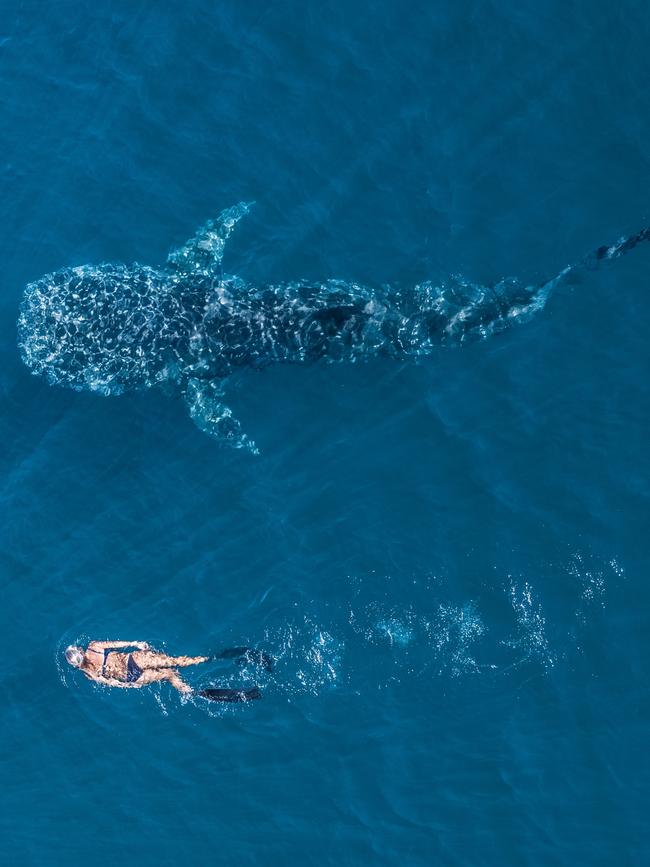
MORE TO THE STORY
Other must-do Exmouth activities:
This rugged reserve, part of the Ningaloo Coast World Heritage Area west of Exmouth, is riddled with spectacular gorges and canyons. There are walking trails, swimming spots and gorgeous beaches, and you might spot emus, kangaroos and black-flanked rock wallabies. Highlights include Charles Knife Canyon lookout, with views across Exmouth Gulf, and a boat cruise through Yardie Creek.
exploreparks.dbca.wa.gov.au
Turquoise Bay and Oyster Stacks
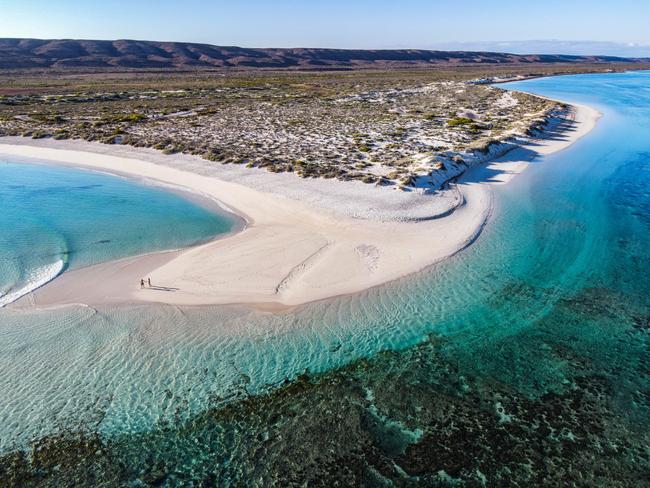
Ningaloo is unique in that the reef can be enjoyed straight off the beaches, many of which are easily accessible via sealed roads. These two sites, within the national park, are popular snorkelling spots.
Ningaloo Aquarium and Discovery Centre
Learn more about the reef without getting wet at this attraction, which is attached to Andrew Forrest’s Minderoo Foundation research facility. Displays showcase upside-down jellyfish, delicate seahorses, and a replica of a 32,000-year-old necklace found in Cape Range. Plus you might spot Miley Cyrus, the naughty crayfish, so named because of her “wrecking ball” skills.
For scrumptious fresh seafood, head to this venue overlooking the pool at Exmouth Escape Resort. Scallops, served with chorizo and tomato salsa, come from the Abrolhos Islands, while local tiger prawns are dished up with gnocchi or in a Creole-style rougail. There are plenty of gluten-free and vegetarian options on the menu.
Navy Pier Dive
Regarded as one of the world’s top dives thanks to the enormous variety of marine life here, this site is part of the Exmouth navy base. Dive Ningaloo is the only operator licensed to access the restricted area. Expect everything from grey nurse sharks to schools of snapper and huge grouper.
Penny Hunter was a guest of Dive Ningaloo and Tourism WA.


To join the conversation, please log in. Don't have an account? Register
Join the conversation, you are commenting as Logout